Technicolor (PA:TCH) is a leading global player in each of its three core businesses: Production Services, DVD Services and Connected Home, all of which have challenges and opportunities. Our view is that management has a strategy to mitigate the former and take advantage of the latter. H119 will likely prove the earnings nadir, with capacity constraints in Production Services and component pricing pressure – now unwinding – in Connected Home, which will also be reflected in the cash flow. We expect cash flow and operating margins to start to rebuild in H219 and through FY20. The current price is well below peer- and DCF-derived valuations.

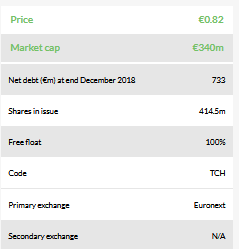
Changing winds
Production Services is at the forefront of industry innovation and its creative and technical expertise is in high demand from the film, TV, animation, advertising and game sectors. The group is now stepping up investment to ease the bottlenecks from capacity constraints, which should allow revenues to grow and margins to improve. The DVD sector is in continuing decline, but the group’s strong market position puts it in good stead for augmenting margins as it renegotiates its large contracts on renewal. Meanwhile, segmental cash generation benefits the rest of the group. The Connected Home market remains highly competitive. Financial progress here is predicated on a three-year cost-saving programme slated to deliver €140m of annualised savings by FY21e.
Improving cash profile from H219
Given the market dynamics over the year to date within Production services and Connected Home in particular, we expect both profits and cash flows to be weighted to H2. Our full-year forecast indicates net debt increasing to €741m by the December year-end (which would be 3.1x our forecast EBITDA) before starting to unwind in the following year as the group returns to being net cash-flow positive. Term loans run to FY23, with modest interest payments in the intervening years.
Valuation: Sum of the parts and DCF point to upside
We have looked at the valuation on a sum-of-the-parts basis split between Entertainment Services (Production and DVD Services businesses) and Connected Home, citing quoted peers (although none are directly equivalent) and at relevant M&A. On conservative valuation metrics, using averages of FY19e and FY20e EV/EBIT for Entertainment Services and EV/EBITDA for Connected Home (EBIT data is not available for relevant transactions), our base-level fair value of €1.10 is above the current price. At a WACC of 8% and terminal growth rate of 2% our DCF indicates a price of €2.74.

Business description
Technicolor is a worldwide technology leader operating in the media and entertainment industry. Its activities are organised in two business segments, Entertainment Services (the combined Production and DVD Services businesses) and Connected Home.
Investment summary
Business drivers: A tale in three parts
Over the last decade, CEO Frederic Rose and his team have whittled down the substantial portfolio of businesses within the group to three, each of which is a leading player in its segment.
- Connected Home (56% of FY18 sales, 33% of adjusted EBITDA): the Connected Home investment case is based on improving margins from an actively reduced cost base. We expect flat sales over the next three years as structural pressures on set-top boxes in developed markets and the drive for share gains via lower prices offset double-digit growth in DOCSIS 3:1 cable modems. Weak H1 US sales, the push for share gains and historically high contract memory prices should restrict margin recovery in FY19. However, by FY20 cost reductions and the recent fall in spot memory prices should be fully reflected in margin. We forecast adjusted EBITDA expanding c 50% from FY18 levels to €128m (6.1% margin) in FY20e.
- Production Services (20% of FY18 sales, adjusted EBITDA disclosed jointly with DVD Services): this is a business with a high reputation for technical skill and creativity in an industry where both these attributes are in high demand. With the emergence of new VoD providers, the demand for high-quality live action and animated content to deliver subscribers or audience is set to continue firm. With a healthy theatrical sector and rising standards of production quality in advertising, the issue here is capacity and managing workflows. The group’s priority is to invest in capacity (people and equipment) to relieve the bottlenecks and improve operating margins through efficiency.
- DVD Services (23% of FY18 sales): the market for physical home entertainment has been in decline for some time, but there are variations by geographic market. Technicolor is a key provider of replication and distribution services to the major studios and, as such, is in a good position to renegotiate its contracts on more favourable terms as they come up for renewal over the next two to three years, which should help to improve margins. In the interim, the operation generates cash to support the rest of the business.
Financials
We expect H119 financial performance to have been testing due to cost pressures in Connected Home and volume-driven productivity inefficiencies in Production Services. However, we expect the former to ease with benefits from reduced component pricing kicking in, while key film projects that have absorbed extensive capacity will be completed. Consequently, we expect to see cash absorption in H119, with most (but not all) being recouped in H219 and the group returning to being net cash-flow positive in FY20, assuming the benefits of the cost-reduction programme in Connected Home play out as expected. We model the group being free cash flow positive from continuing activities in FY19e (negative in H1). Potentially improved contract terms in DVD Services are not factored in.
Valuation: Clearly below fair value
On a sum-of-the-parts basis, we have derived a base-case valuation of €1.10 per share. This is calculated from peer-based EV/EBIT multiples for Entertainment Services and EV/EBITDA for the Connected Home business, averaged across FY19e and FY20e. We have also carried out a DCF analysis using a WACC of 8% and a terminal growth rate of 2%. This derives a value per share of €2.74. This represents considerable upside from the current share price of €0.82, which has drifted down from €1.25 in March 2019 (€0.94 at the start of the year). Catalysts for a re-rating could include progress on the profit improvement plan in Connected Home, successful renegotiation of DVD contracts and successful capacity debottlenecking in Production Services as a result of the ongoing investment programme.
Company description: Media and entertainment
The group was listed in France in 1999. CEO Frederic Rose joined in 2008, tasked with improving the financial performance of the group and to refocus it to reinforce its position as a technology leader in the market. At that stage, the business comprised a large number of diverse activities, meaning repositioning the group has not been straightforward. The M&A activity over the last few years is shown below in Exhibit 11.
Market leader in three entertainment-focused activities
There are now three core activities remaining, all of which hold a dominant position in their market segments, meeting the key criterion set by management for their retention. The revenue split of continuing business by activity and by geography is shown below. EBITDA split, however, is published by Entertainment Services and Connected Home, the former being the combined Production and DVD Services. These activities serve different markets with varying characteristics and we describe each in more detail below.
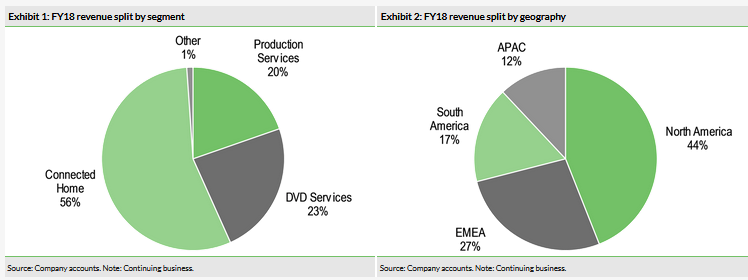
Production Services
The Production Services segment comprises seven brands, providing visual special effects (VFX), animation and post-production services. These are provided for the film, TV, VoD, advertising and games industries. Key brands are identified below, along with their key activities and markets and physical locations. Throughout this document we use the term VoD to include transactional (TVoD), advertising supported (AVoD) and subscriber (SVoD) models, sometimes known as over-the-top (OTT) services.
Historically, these brands operated with a high level of independence. More recently (from end 2017), they have been brought closer together, with a greater degree of collaboration. There is now a customer-focused organisational structure, based on Film and TV VFX, advertising, animation and games and post-production. Alongside the potential for cross-referral of business to other group brands, this structure has facilitated some pooling of talent recruitment. It also increases the attractiveness of Technicolor as an employer through offering career development and international opportunities. With more than 10k employed in the segment, including just under 8k digital artists, recruitment and staff retention are key to delivering client work on schedule and to a high standard in a growing market where capacity and efficiency are under pressure.
Technicolor customers include the major film studios, the independent studios, the TV production companies and the VoD providers on both VFX and post-production. In advertising, it works for the global agencies and production companies, as well as for smaller, local, agencies and directly for brand owners and advertisers. In the animation and games markets, the major and the independent animation studios are clients, alongside the children’s TV networks and games publishers and developers.
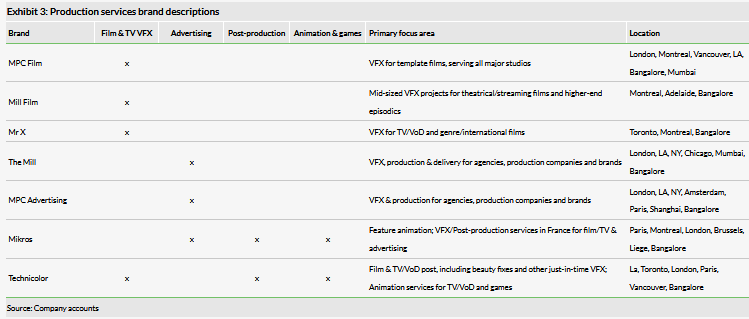
In 2018, the group worked on more than 40 films from across the major studios, including more than 12k VFX shots, in addition to over 3k VFX shots for TV/VoD content. This included titles such as Aquaman for Warner Brothers, Fifty Shades Freed for Universal and The Predator for Fox. Mr X worked on 14 TV projects, including Vikings (History channel), American Gods (Starz) and Narcos and A Series of Unfortunate Events (Netflix (NASDAQ:NFLX)). In post-production, the tally was over 300 theatrical releases and 470 series/miniseries/pilots, including high-profile projects such as Avengers: Infinity War and Black Panther for Disney/Marvel, Ant-Man and the Wasp for Disney and Roma for Netflix in film. TV projects included The Romanoffs for Amazon (NASDAQ:AMZN) and Black Mirror for Netflix.
Technicolor companies also worked on over 5,750 commercials, including Apple’s Unblock and the 2018 John Lewis Christmas campaign, The Boy and the Piano. Group brands produced over 2,600 minutes of animation for TV and film and 15k computer generated (CGI) assets for top-selling video games, TV and films, with Mikros working on Stubby: An American Hero for Fun Academy and Sherlock Gnomes for Paramount. In TV, projects included Alvin and the Chipmunks seasons 3 and 4 (Nickelodeon) and Kung Fu Panda: The Paws of Destiny (DreamWorks Animation/Amazon). The in-house original content production company produced 30 commercial half-hours and has new series green-lit for the current year. Games delivered in 2018 included NBA 2K19 (2K Sports/Take-Two), FIFA19 (EA Sports), Assassin’s Creed Odyssey for Ubisoft and Call of Duty Black Ops 4 for Activision.
Projects can last up to 18 months, mixed in with smaller, fast turnaround projects, making rostering and project management a challenge to match demand to available resource.
The broad spread of customers and segments supplied ensures there is a high base load of work, which has been bolstered by the increase appetite for high-end content from the VoD providers and from the growth in VFX-heavy movie franchises. Studios are increasingly likely to outsource animation, particularly on mid-budget productions, whereas the continuing strong development of the games segment is driving games developers to step-up the quality of the user experience. Technicolor continues to develop its expertise in virtual and augmented reality to provide a complete package of enhancement options.
DVD Services
Technicolor is the world leader in replicating, packaging and distributing physical media for video, games and music on DVD, CD and Blu-ray discs. This business segment has a high concentration of customers, including Warner Brothers, Disney, Paramount, Universal, Sony DADC, Fox and Lionsgate. It also works with smaller independent studios, games producers and the major music publishers. Key manufacturing facilities are in Mexico and Poland, whereas packaging and distribution are based in Tennessee and Alabama in the US. Typically, Technicolor will have multi-year contracts with each customer, with exclusivity and time commitments built in.
With the acquisition of Cinram in late 2015 and the outsourcing agreement with Sony DADC in North America and Australia, which took effect in Q218, Technicolor became the world’s largest replicator of DVD and Blu-ray disc units, ahead of Sony (which is currently proposing taking out further replication capacity in Europe) and Arvato, part of the Bertelsmann organisation. Both of these groups are focused on European markets. Technicolor’s outsourcing arrangement with Sony DADC was extended into distribution in the early part of FY19.
In FY18, the group replicated 1.2m discs, shown split by format and by segment below.

These figures were boosted by the outsourcing agreement reached with Sony DADC. Despite this, volumes were down 11%, reflecting the continuing decline in the underlying markets as streaming has gained traction. Within this, Blu-ray volumes were up by 12.5% year-on-year.
The underlying market for DVDs has been declining for a number of years. Research published by the Motion Picture Association of America indicates consumer spending on the global physical home entertainment market shrinking in retail value from $25.1bn in 2014 to $13.1bn in 2018, a CAGR of -15% over that period. The US accounts for 44% of the total spend. Technicolor’s increasing share of the supply to this market has helped offset some of this decline.
Connected Home
Customer premise equipment (CPE) provision is a large ($16.4bn in FY18) but tough market. There is little overall growth, margins are thin and visibility limited. In our view, the key to prospering in this commoditised environment is scale. Scale gives access to cheaper components and leverages platform development costs – savings that can be passed on to customers, re-invested in developing new platforms or retained as higher profits. Technicolor is the second largest CPE player globally with a share (ex China) of c 17% in FY18. Although it is vying for market leadership with Arris (US acquiror of Pace, recently acquired by CommScope), it is three times larger than Humax, the next largest player. With adept management, Technicolor can exploit its scale advantage to drive further share gains and ensure healthy returns even in lean years. Given the thin margins, even modest improvements in market conditions can lead to big increases in profits.
Network operators (cable, satellite, telcos) provide routers and modems to enable their residential customers to access to the internet (Connected Home’s broadband segment) and set-top boxes STBs to access and store encrypted broadcast video streams (Video). For network operators, the devices are important service differentiators: the latest features help attract new subscribers, drive upsells and reduce churn. Network operators typically partially fund the cost and control both the specifications and the pace of deployment.
The technology is evolving rapidly. Network upgrades are delivering huge increases in internet access speeds, enabling telcos to compete directly against satellite and cablecos in video provision for the first time. Fibre deployment promises speeds of up to 1Gbit/s in urban areas while upgrades to DSL (copper) are increasingly becoming fast enough elsewhere. In response, cable operators are rolling out DOCSIS 3.1, a technology that can boost download speeds nearly tenfold to 10Gbit/s. Technicolor estimates the broadband CPE market is growing at a 4% CAGR. Aided by its strong position in DOCSIS 3.1 in the US, its broadband segment grew 36% y-o-y in FY18.
However, rising broadband speeds and changing patterns of media consumption are enabling OTT service models to challenge the traditional cable and satellite broadcast video model. Using either dedicated hardware (dongles or boxes) or apps installed on smart TVs, players such as Netflix or AppleTV or Google (NASDAQ:GOOGL) Chromecast can now stream high-definition internet content direct to the TV. This transition is affecting STB sales. Technicolor estimates the video market is declining at 4% CAGR. Exacerbated by end of Charter’s deployment of WorldBox during H1, Connected Home’s US STB shipments fell 60% y-o-y in FY18. Outside the US, this transition is driving a shift towards cheaper, often android-based, boxes with little or no storage. This trend can be seen in Connected Home’s FY18 results where STB shipments ex-US rose 20% y-o-y but average selling prices (ASPs) declined. In our view US STB shipments should begin stabilising in H219 (at a low base) but we would expect further declines in the STB market in the long term.
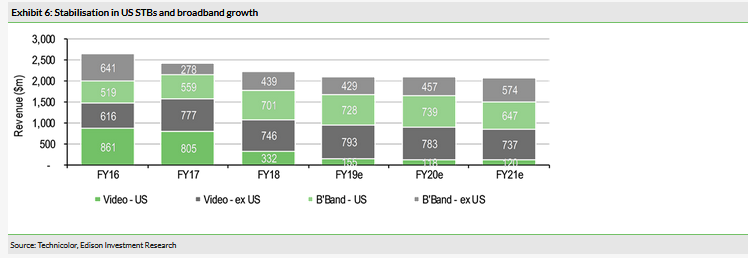
Critical to Connected Home’s ability to maintain its scale advantage is securing dominant positions on fast-growing technology platforms such as DOCSIS 3.1. It is sole supplier of DOCSIS 3.1 at Comcast (NASDAQ:CMCSA), the largest cable operator in the US and is also supplying Charter (number two). With a growing roster of wins outside the US, it has established a clear leadership position in a technology that we would expect to sustain double-digit growth in both FY19 and FY20. Connected Home is also well positioned in ultra-high definition (UHD) (4k) video. UHD accounted for a third of its video revenues, growing y-o-y despite the overall decline in STB. Aside from preserving and extending its scale advantage, the higher ASPs and greater scope for differentiation on these more advanced products typically attracts richer margins.
One of the most significant trends in the CPE market over the last two years has been the impact of rising commodity memory prices on the bill of materials. We estimate Connected Home’s total spending on DRAM and NAND components was about €240m in FY16 (c 9% of sales). However, between 2016 and its peak in early 2018, average DRAM prices approximately doubled and NAND rose 25%. The company estimates these price rises increased its costs by €120m, equivalent to 5pp of FY18 margin and over 135% of reported EBITDA.
To offset this, Technicolor announced a three-year plan to cut annual fixed costs by €140m or 40% by FY20. It also publicly stated that from July 2018 it would pass on the impact of further price rises to its customers. At the end of FY18 the company said it had ‘significantly mitigated’ the €45m impact of component price increases in FY18 through this cost-saving plan.
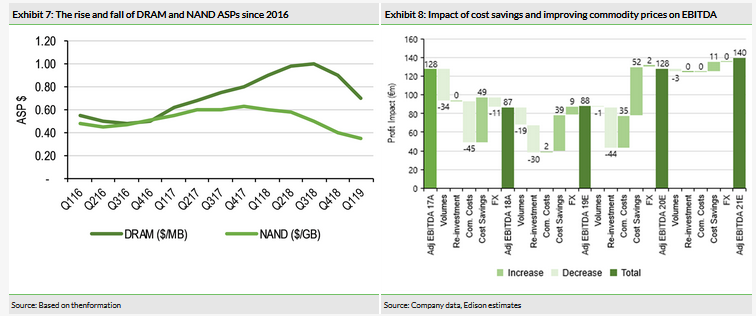
Since this announcement, commodity chip prices have fallen substantially. The spot DRAM price has fallen by over 30% in FY19 ytd and is now close to FY16 levels, whereas average NAND prices have halved from their peak and are now below where they were in FY16. This has led some investors to speculate that a surge in profits is imminent. Adding the remaining c €90m (4pp of margin) of annualised cost savings to be delivered to a full reversal of the commodity cost cycle (€120m or 5pp) would suggest (unprecedented) double-digit margins.
In our view, although margin expansion is probable, it may not be as dramatic as the market anticipates. Spot-price movements take time to feed into contract prices and we expect commodity costs to be broadly neutral in FY19. More significantly, Technicolor has explicitly stated it intends to re-invest most of the benefits of a lower bill of materials in market-share gains. The combination of pressure in STBs and deliberate action to lower ASPs to gain share is likely to results in a further modest decline in revenue, which will impact profits. Our analysis suggests Connect Home should significantly increase EBITDA from €88m in FY18 to €128m (6.1% margin) in FY20e, with a modest further improvement in FY21e.
Strategy focused by activity
The group has been significantly restructured over the 10-year tenure of CEO, Frederic Rose. From a plethora of lines of business, management has focused on those where the group has a credible claim to be market leader. There have also been purchases to infill and consolidate the group’s position in certain segments.
This has resulted in the group comprising the current three activities, organised into the two segments Entertainment Services and Connected Home. The strategy for developing the group and its profitability is a combination of the strategies for each element.
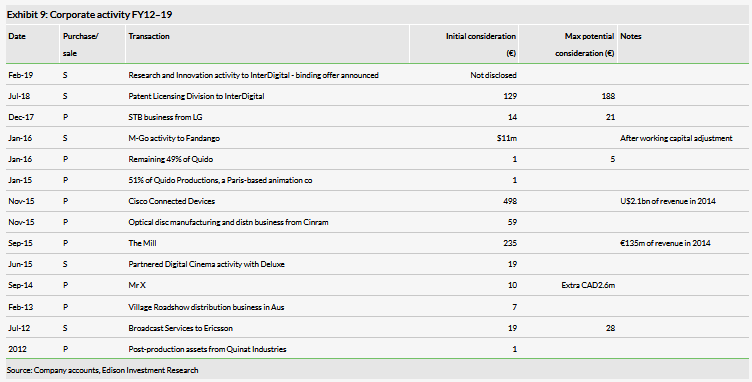
Production Services. As outlined above, Technicolor is a leading provider of services to content creators, in a market where content is highly sought after and supply is inherently limited. The search by the content distribution channels (film, TV, SVoD, AVoD) for impactful content that will drive viewer numbers and market share leads to strong demand for high-end content. This often needs VFX, extensive post-production or additional service input. The continuing popularity of animated CGI content both in film and TV is leading to the major studios outsourcing a proportion of their productions.
The post-production market is more mature. Technicolor’s experience and reputation continue to attract the staff to maintain and build its market share. The games market is becoming an increasingly important element in the consumer entertainment market mix and production quality is rapidly ramping up. Additional demand for immersive content from advertisers and from B2B communication channels is creating further commercial demand.
Therefore, capacity is the key business issue that needs to be addressed, with both additional creative and technical staff and the equipment on which they work needed, alongside developing technologies that enable production be optimised for speed and efficiency. The group is investing in additional capacity, particularly in India, France (where VFX tax credits are available), Australia and Canada. This should ease the current bottlenecks and allow for stronger revenue growth and improved levels of profitability.
DVD services. Overall volumes in physical entertainment media have been in decline for some years as streaming has become more popular This has affected the profitability of the division (together with the increasing complexity of orders as the proportion of blockbusters in the mix of physical home entertainment has fallen).
Technicolor intends to renegotiate contracts as they come up for renewal over the next couple of years, incorporating volume-based pricing to protect its margins and restore profitability. The distribution fees will be the key element to put the business back on a proper commercial footing.
Management is also looking at expanding the range of product categories handled through the distribution chain, leveraging the logistical expertise and the infrastructure in which it has invested over the years. The opportunities here could be considerable, given the changes to global retail markets as shopping patterns shift more heavily to online.
With limited investment requirement, the division will also focus on generating cash that can be used to support the expansion of production services.
Connected Home. The acquisition of CISCO’s Connected Devices in 2015 established Connected Home as a leading global provider of residential CPE. Aside from doubling its size and market share to 15%, the acquisition added cable-modem technology and a presence in the strategically important North American market.
Scale is an important advantage in a market with traditionally thin margins. It gives access to lower component costs, which can be either passed to customers in lower prices to drive share gains, re-invested in developing new platforms or retained as higher profits. Connected Home is focused on segments and geographies where it holds the first or second position and vies with Arris (now owned by CommScope) for global leadership, with other players lagging substantially. Scale has also enabled it to weather a surge in commodity component pricing in 2017 and 2018 and remain profitable. In 2018 the division launched a three-year transformation programme to reduce annual fixed costs by €140m, or 40%. Combined with a reduction in component prices, this programme should lead to improving margins in FY20.
Key to Connected Home maintaining its scale advantage in the long term is securing dominant positions on fast-growing platforms and sub-segments. It is the clear market leader in DOCSIS 3.1 and its UHD products now account for over a third of its video revenues. Participation in further M&A activity, as either a target or an acquiror, could further consolidate this market and enhance Technicolor’s scale advantage.
Sensitivities
With three diverse business streams based in a variety of geographies, the group’s risk factors are far from uniform.
- Connected Home’s hardware sales model offers investors little visibility. Customer deployment can drive rapid shipment growth in short periods but can fade just as quickly. The recent hike in memory costs further highlights the sensitivity of its margins to component prices. While geographic and customer diversity insulate Connected Homes from the extreme swings in individual markets and management has been proactive in reducing costs to preserve margins, profits can vary substantially from year to year.
- Production Services’ main issues surround the management of workflows, with often high-profile projects on tight timescales for clients with demanding expectations of technical and creative competence. Having the right staff in the right place is a key part of the package. Confidentiality is also key for both physical and digital assets. The group needs to maintain its position at the forefront of technical innovation, including AR, VR and AI. Where clients chose to place business can also depend on the availability of appropriate tax credits, which may limit the group’s ability to transfer work between facilities.
- DVD Services has inherently high customer concentration, with a limited pool of potential customers. Across Entertainment Services, the top five clients accounted for 47% of FY18 revenues, 20% of the group’s total. DVD Services has multi-year contracts, with varying terms and expiry dates. Successful renewal of these is core to delivering on market expectations. Management anticipates being able to renegotiate on improved terms, which would lead to higher expectations of profitability. In terms of business risk, the operation needs to continue to deliver high-quality products on tight timescales, so competent management of raw materials and production facilities is crucial.
Overall, the group is relatively highly geared, with gross debt of €1,024m (net debt of €733m) on shareholders’ funds of €254m, which acts as a constraint on increasing its exposure to the higher-growth, higher-margin aspects of its business.
Other sensitivities include currency fluctuations, key individual exposure and the standard IT/cyber security issues.
Valuation
Sum-of-the-parts is the most appropriate methodology
Given the different business models and Technicolor’s proactive approach to managing its portfolio, we believe a sum-of-the-parts (SOTP) valuation approach is the most appropriate. We have also looked at a DCF on a combined group basis.
Given that beneath the revenue line, Production services and DVD services are not separately identified, the relevant segments are Connected Home and Entertainment Services.
Entertainment Services
For this part of the business, we have looked at the valuations of various global peers. These peers are not necessarily directly comparable but operate in a similar field for some or all of their business models.
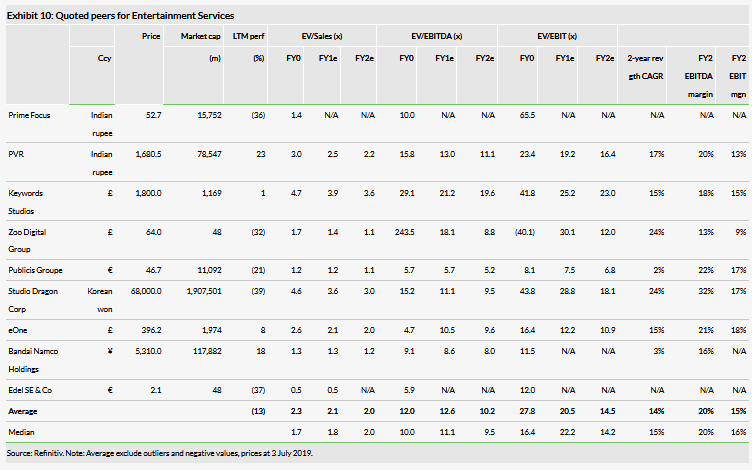
It is not surprising that these businesses have had a wide variance in stock market performance, as each has a unique set of operational stimuli, rather than reflecting general market conditions. There is a wide range of earnings multiples, with assets in fast growth areas such as games accorded a significant premium over the more traditional model of a marketing services holding company, such as Publicis.
Given the varying business models and the additional variance of accounting treatments, particularly where there are potentially considerable sums of capitalised costs in film production, the EV/EBIT multiples give the more reliable basis for comparison, as well as deriving the most conservative figures. The current year EV/EBIT of 20.5x implies a valuation for Entertainment Services of €492m; for FY20e, the equivalent number is €479m. It should be noted, however, that comparator companies on average generate higher margins (peer group average FY20e EBITDA margin of 20% vs Technicolor’s forecast 12%) and are increasing their revenues at a faster rate (peer group average 2Y CAGR of 14% vs negative CAGR for Technicolor.
We also note there has been recent corporate activity in the sector, with the most notable examples listed in Exhibit 11, below. However, it is also worth noting these were off-market deals from single vendors, so would not necessarily carry any premium to the pricing.

Taking Entertainment Services’ historic EBITDA of €178m and putting it on a 22x multiple accorded to The Foundry implies an EV of €3,916m. We again prefer to look to the more conservative approach. Given that we do not estimate the split of debt between the business segments, to look at the PBT multiple requires an assumption on the relevant interest burden. If we assume that half relates to Entertainment Services and half Connected Home, then the historic segmental PBT would be €23m. Putting that on a 25x multiple (the average of the two in Exhibit 11), we derive an EV of €563m.
Connected Home
Connected Home’s closest listed peer, Arris, was acquired in November 2018 for $7.1bn (1.1x LTM sales, 11.2x EBITDA) by US network equipment supplier, CommScope. At the time of acquisition CPE generated approximately 25% of Arris’s profits. The remaining listed consumer electronics companies with CPE exposure, Korea’s Humax and China’s Skyworth Digital, are unsuitable peers as Humax is subscale and Skyworth Digital predominantly sells TVs.
In the absence of relevant listed peers, we derive an LTM EV/EBITDA trading multiple of 7.9x from the last undisturbed valuation of Pace and Arris before their acquisition (2015 and 2018 respectively). Applying this to our FY19 Connected Home’s EBITDA forecast of €88m generates a valuation of €0.7bn. However, with the full benefit of cost savings and lower commodity prices not reflected in our FY19 forecast, FY20 arguably provides a useful indication of the valuation. Applying a 7.9x to our FY20 EBITDA estimate suggests a valuation of €1.0bn and implies an EV/sales multiple 0.5x.
As we believe further consolidation in the CPE market is likely, it is appropriate for a valuation of Connected Homes to reflect take out prices. Pace and Arris were acquired at a 24% and 27% premium to their listed valuation, implying an average LTM EV/EBITDA multiple of 10.0x. Applying this multiple to our FY20 EBITDA forecast for Connected Homes suggests a valuation of €1.5bn.
Sum-of-the-parts valuation
As we consider the financial projections to be around an inflexion point, we have used an average of FY19e and FY20e multiples for the two business segments to derive our SOTP valuation, then subtracted a net estimate for corporate overheads on a 10x target multiple to arrive at an equity value. This generates a group EV of €1,188m and equity of €455m, equivalent to a value per share of €1.10, as shown below.
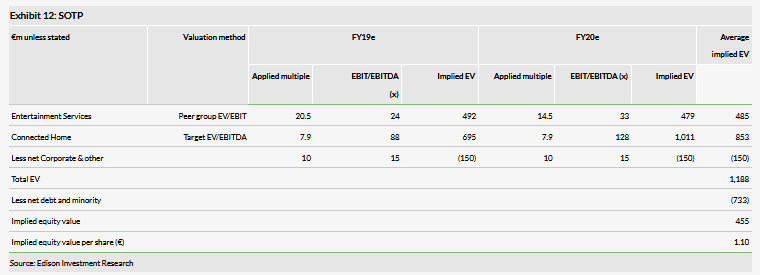
DCF sense check
We have also looked at the implied valuation using a traditional DCF methodology, based on a WACC of 8% and terminal growth of 2%.
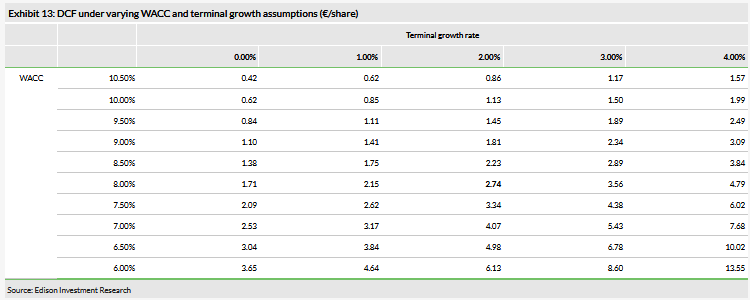
This generates an implied valuation of €2.74, ahead of the earnings-based valuation shown above. This gives us a valuation range of €1.10 to €2.74, well ahead of the current share price of €0.82.
Share price catalysts
The current valuation is at the bottom of historic trading ranges (see Exhibits 14 and 15) and is clearly significantly below both valuation measures illustrated above. This implies that the market does not fully recognise the value inherent in the underlying business, as investors might be concerned with the weaker near-term financial performance and/or the level of debt that could compromise management’s ability to take advantage of market opportunities. While it is understandable that there might need to be a transition period in the short term, especially given the current pace of change in the portfolio businesses, the current EV of €1,069m (equity of €336m) appears to be very conservative and does not discount the future growth of Production Services and the turnaround potential of Connected Home:
- The longer-term growth in Production Services is predicated on increased capacity, relieving the current bottlenecks. Structural trends towards greater use of CGI, AR and VR and the growth in video and experiential gaming are positive for this business, with Technicolor’s reputation and leading market position placing it in a strong position to benefit. On the back of the company’s increased investment in production capacity, we expect revenue to grow and margins to improve (see Exhibit 16 below).
- DVD Services is set to renegotiate contracts with its major clients. If management achieves its objectives to build in volume-based pricing and minimum guarantees, then this business becomes (potentially significantly) more profitable, despite falling revenues. Adding in other logistics/distribution contracts to utilise existing over-capacity, should also help margins. Our forecasts assume only modest progress and may prove over-cautious.
- Connected Home is broadly a turnaround story, with improving profitability driven by management’s three-year programme to drive down costs by €140m. The lower price of components will also help.
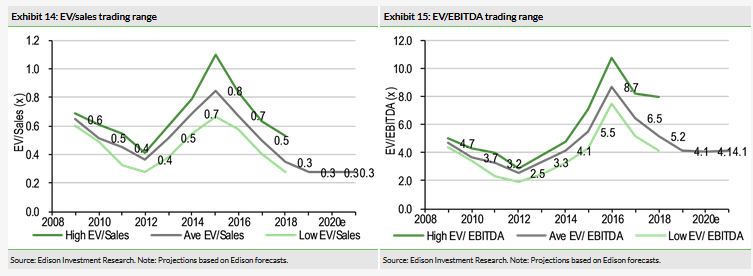
Financials
We present figures for the continuing business as this gives the greatest clarity over the financial performance and potential. Due to the changes and downsizing of the underlying portfolio, there have historically been restatements of prior-year numbers. We use these restated figures in all our exhibits.
We have modelled the financials based on the segmental splits set by the group, as shown below. Within Entertainment Services, the growth we anticipate in Production Services’ top line as capacity increases is offset by the decline in revenues from DVD replication and distribution services. The scale of this decline may be mitigated by the adoption of other logistics contracts, but we make no assumptions on the timing or scale on this for now. The dynamics behind the modelling of Connected Home were described in some detail above.
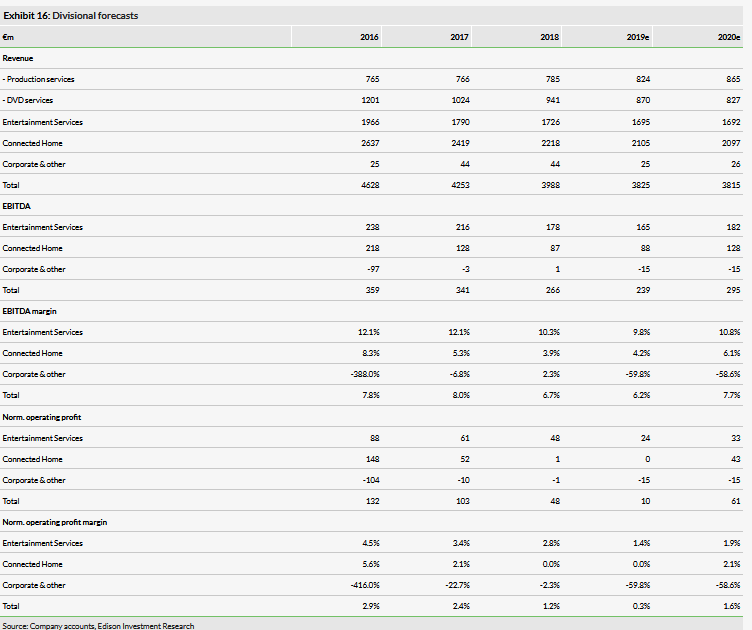
There is a slight historical bias to the second half for revenues, with an inherent seasonality in the DVD business and we would expect the interim results due shortly to follow the same pattern, perhaps exacerbated by the trading factors referred to above.
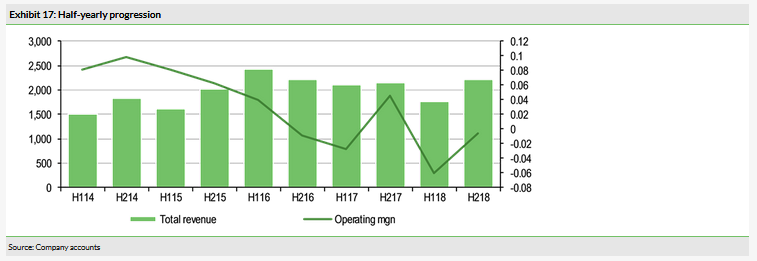
We anticipate that FY18 will prove to have been the trough year for margins. The three-year transformation programme for Connected Home, initiated in H218, is set to reduce annual fixed costs by €140m or 40%. Along with the reduction in component prices, this should lead to improving margins in FY20. For FY19, input costs will remain high in the first half as inventory purchased at higher prices is utilised, but improvement should start to flow through in H2.
Within Entertainment Services, the key H119 financial performance revolves around the timing of costs and revenue recognition. The major Disney project, The Lion King, has carried longer into the current financial year than originally anticipated and has required intensive resourcing, which has diverted some people from other projects and led to some temporary inefficiency. We would expect the position to be more satisfactory in H2, improving further in FY20 and beyond as the group expands its capacity, with a benefit to margin through adding capacity in regions with lower employment costs than London and LA.